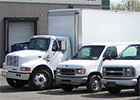Delivery Fleet Costing Your Business Money?
 The cost of owning and maintaining your delivery fleet makes up a significant portion of the overall cost of running your business.
The cost of owning and maintaining your delivery fleet makes up a significant portion of the overall cost of running your business.
While some fleet costs cannot be reduced without compromising the quality of your delivery service, others can be lowered with little or no negative impact on your small business.
Here is a look at the various costs of operating a delivery fleet, and some measures you can take to keep them low.
Types of Fleet Costs
Vehicle Costs
The cost of buying vehicles is usually the greatest expenditure incurred in running a delivery fleet. With the prices of vehicles rising, you have to be prepared to spend substantially more if you are planning to add new vehicles to your fleet.
Insurance Costs
It is essential that you purchase sufficient vehicle insurance to protect your business against losses that can result from accidents and other auto-related misfortunes. Depending on the size of your fleet, insurance can be a sizable expense for your company.
Fuel Costs
Delivery vehicles can use large amounts of fuel when they are fully-loaded. The average retail gas price in the US has increased by about $0.45 per gallon since the beginning of the year, and it is difficult to predict whether it will rise or fall in the near future.
Maintenance Costs
In order to provide efficient delivery service, you have to make sure that your vehicles are always in a good condition. Regular maintenance, such as oil changes, transmission fluid, tire replacement, brake pads and air filters, and repairs can cost a considerable amount of money.
Transportation Employees
Other than wages, you also need to pay taxes and provide insurance for your transportation employees. New drivers may have to undergo training in order to perform their duties competently, which is an additional cost to your company.
How to Reduce Your Fleet Costs?
Buying Vehicles
It is important that you do thorough research before you purchase new vehicles for your fleet.
Contact a few reputable dealers to find out the prices as well as incentives and rebates they offer for the vehicle of your choice. Then, compare their offers and choose the one that offers the best deal.
You can save substantially on fuel by purchasing diesel vehicles or fuel-efficient vehicles. If you are delivering goods over short distances, you may want to consider buying electric or hybrid vehicles. Also, make sure you find the most cost-effective way to finance your purchase.
Getting Insurance
Similar to purchasing vehicles, you need to do comparison shopping to find the best auto insurance deal.
Most insurance providers offer a wide range of discounts that can reduce your insurance premiums significantly, such as safe driver discount, multi-vehicle discount, safety and anti-theft devices discount, and others. Try to qualify for as many discounts as possible.
Route Planning
Good route planning does not only enable your drivers to deliver goods faster; it can also reduce fuel costs and vehicle wear and tear.
Instruct your drivers to find the most fuel-efficient routes first before they set off to make deliveries.
Other than the costs mentioned above, there are also hidden fleet costs that can affect your profit margins considerably.
As such, it is important that you have an elaborate plan for identifying and reducing your fleet costs.
John McMalcolm is a freelance writer who writes on a wide range of subjects, from social media marketing to Cloud computing.

 Delicious
Delicious Digg
Digg StumbleUpon
StumbleUpon Propeller
Propeller Reddit
Reddit Magnoliacom
Magnoliacom Newsvine
Newsvine
Comments
Post new comment